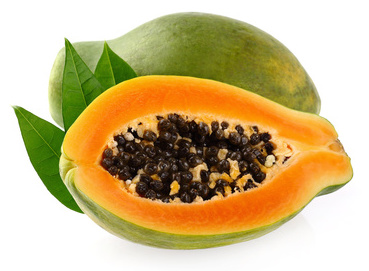
Health Benefits:
Aids in digestion
Aids in weight loss
Anti fungal
Anti inflammatory
May reduce anxiety
May reduce risk of osteoarthistis
Prevents sinusitis
Provides energy
Relieves cramps
Nutrition:
Serving size: 1 fruit; Calories: 67; Fat: .4g; Cholesterol: 0mg; Sodium: 13mg; Carbs: 15g; Fiber:3g; Sugars: 9g; Protein: 1g; Potassium: 8%DV; Vitamin A: 33%DV; Vitamin C: 159%DV; Calcium: 3%DV; Iron: 2%DV
Did You Know?
- The skin of a Papaya can be used as a external treatment of skin wounds to speed up healing time.
- Young papaya fruit contains enzyme called papain. Papain has been used as a natural meat tenderizer for thousands of years.
- Papaya seeds resemble peppercorns and are edible. They can be ground up and used as a substitute for black pepper.
Ways to Eat:
- Raw
- In salads
- In sorbet
- With yogurt
- Blended in a smoothie
Farming Trivia:
- Papaya originally came from southern Mexico and northern parts of South America
- Papaya was introduced to Hawaii in the early 1800s. Today, Hawaii is a U.S. state that is the only commercially cultivated papaya
- In Australia, papaya is referred to as "Papaw" or "Paw Paw"
Note: Always consult a physician for any specific health questions and concerns. Some of this information may be subject to change should there be any new findings from Federal Health Administration (FHA), Food & Drug Administration (FDA), American Medical Association (AMA), American Cancer Society (ACS), and / or other leading food, nutrition and medical advisors.

